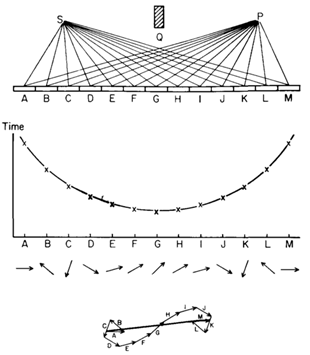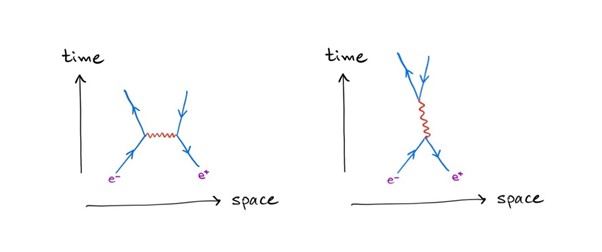A few months ago, I attended a Royal Institution talk on The Quantum Smart City by Ruth Oulton, and as of recent, I finished reading Richard P. Feynman’s QED, short for Quantum Electrodynamics.
The Royal Institution, the home of groundbreaking science discovery, welcomed Professor Ruth Oulton, a professor of Quantum Photonics at the University of Bristol. Oulton is known for performing experiments to explore how to use specialist semiconductor chips to manipulate single particles of light used for quantum technologies. She runs a laboratory, is the academic lead of Bristol Quantum Technology Innovation Centre and advises on international quantum technology policy.
Richard Feynman was a renowned theoretical physicist, at the forefront of quantum electrodynamics. Feynman was known for visualising particle interactions, contributing to the development of the atomic bomb, quantum computing and nanotechnology. Feynman received the Nobel Prize in Physics in 1964 for his contributions to the development of quantum electrodynamics. Feynman was known to popularise physics through his books and lectures, one of which is recorded in the book QED: The Strange Theory of Light and Matter, published in 1985.
The Quantum Smart City
Professor Oulton painted the picture of a city designed to dynamically run itself using real-time data. From the changing of traffic lights to maximise efficiency to the distribution of energy depending on the weather or time of day. This is a future not too far off, where cities are responsive systems that adapt to the needs of those who inhabit them.
However, this doesn’t come without tensions. With such a large amount of data being collected, the ethics of data privacy and surveillance begins to emerge.
At the centre of these advancements is quantum mechanics. Quantum particles often don’t behave in ways that we expect, to which Richard Feynman beautifully describes as resulting in “the erosion of our common sense”. One example of this is how a single photon isn’t just both a wave and a particle simultaneously, but further travels through every possible path to reach a destination.
This is where Feynman’s lecture series, QED, comes in, explaining the interactions between photons and electrons with his groundbreaking ideas.
Oulton further explained the use of the same wave-particle duality, interference and unpredictability, utilising them as tools. Quantum sensors, communication and navigation were all raised in her talk – exploiting all things that make quantum physics so odd.
With the rise of smart cities there is also an expected development for that in data privacy, the issue raised earlier. Traditional encryption methods are generally strong but are no match for the power of quantum computing. This is where quantum key distribution can be used. A single photon can be used to transmit the keys, making it physically impossible for someone to eavesdrop without being detected. It is not secured by pseudo-randomness, which we rely on for traditional techniques, but actual randomness and quantum laws. An intruder cannot copy a photon’s state without disturbing it. This quirk allows for uncrackable encryption (for now).
Oulton further showed a real-life example from Bristol, where multiple buildings are now connected in a quantum network. This is just the start of a very exciting future. One such example of this could be a city where heart rate data is shared, but with secure quantum systems, people could contribute data truly anonymously – helping the design of calmer spaces, set to purpose around cities.
These quirks of light and matter are now turning into physical fibre-optic cables, secure transmission and servers and soon to be autonomous systems. However, this still leaves the question of how do these quirks work.
QED: The Strange Theory of Light and Matter
Feynman’s book is based upon a series of four public lectures he gave, aiming to explain quantum electrodynamics to those without a degree.
The first chapter introduces photons, packets of electromagnetic energy. Feynman showed that when photons, what we already discovered were both waves and particles, reflect off glass or mirrors they do so unpredictably. While we can understand what the overall effect of the photons will be, we cannot predict what an individual photon will do, only the probability can be calculated. This is shown by arrows. Each arrow representing a probability, the direction and length describing how likely it is to occur. These arrows are then added together to predict what’s likely to happen across many photons.
 Each path the light to go is shown at the top, with a point on the graph below showing the time it takes a photon to go from the source to that point on the mirror.
Each path the light to go is shown at the top, with a point on the graph below showing the time it takes a photon to go from the source to that point on the mirror.
The second chapter spoke on electrons, similar to photons, behave both like waves and particles, and also have probability arrows. Feynman described how electrons interact with photons and can be drawn in diagrams, what we now call Feynman diagrams.
 Feynman Diagrams
Feynman Diagrams
Feynman used these diagrams to track how particles move and interact over time and thus can be used to predict events with remarkable accuracy.
This leads into the third chapter of the series, calculating probability in the quantum world. Utilising the arrows of probability, these can cancel each other out or boost each other. These are known as destructive and constructive interference. This does not just show whether something can happen, it’s instead how all the different possible paths interfere with each other. This links to the lecture on quantum cities and how everything is built on the idea of what happens is not a certainty, but instead the result of every possible thing happening, all at once.
The final chapter and lecture in the series addresses the loose ends across QED. Feynman goes to admit how quantum electrodynamics is strange and frustrating, but it works. He accepts the gaps in our understanding and the weirdness of everything that is happening. It is refreshing, while also unnerving, that a scientist at the forefront of his time doesn’t have all the answers, but instead there is a love to the mystery of it all.
To Conclude
Across the lecture from Ruth Oulton and book from Richard Feynman, I have certainly been exposed to the quantum world, and this is the future of technology and while some parts are just abstract theory, it will eventually be involved in the building of the infrastructure in cities of the not too far future.
- Cover Image by Dynamic Wang on Unsplash.
- QED: The Strange Theory of Light and Matter by Richard Feynman.
- Feynman Diagrams - Pioneer Works.
- The Quantum Smart City - Royal Institution.